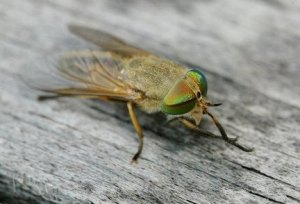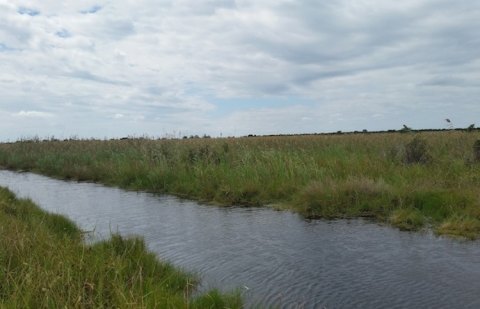Have you ever been lying about on the beach, soaking up the sun, and listening to the ocean’s waves crash, when all of a sudden you feel a searing, intense pain? Or maybe you were out for a stroll along the beach or bike ride on the highway when you experienced an awful, stinging feeling? I’m talking about being bitten by one of those large, terrible insects that thrive along the coast, and are commonly referred to as Greenheads.
Now, some people call them Greenheads, others call them Horse Flies, and both are correct. Greenheads, or Tabanus nigrovittatus, are a type of Horse Fly that loves the salty marshes which surround Ocracoke and other coastal locations from Texas all the way up to Nova Scotia. But regardless of what you call them, I’m sure you know one when you see it. The past few months would have produced the highest numbers of greenhead horse flies for this season, but we’re not out of the woods yet.
These flies actually have teeth. TEETH! Sharp, scissor-like teeth! That’s why you’re more likely than not to bleed after being bitten. The female flies are the ones that do all the biting, and once your blood has been turned into dinner, she’ll go off and lay anywhere between 100 and 200 eggs. Yeck! The males are vegetarians (thank goodness), relying on nectars and fruits for food. Their peak month is typically July, but they usually start popping up in May and June and can stay around through September. Greenheads are known for being relentless and vicious, and are attracted to wet skin, so stay aware of these biting nuisances.

Unfortunately, since these insects are so large, personal bug repellent isn’t really an option in bite prevention. Personal bug repellent and pesticides are only effective when trying to keep smaller insects at bay (mosquitos, no-see-ums, etc.), so you’ll just have to rely on your ninja-like reflexes when venturing into a marshy area.
Of course you can smack and squash those dag-on things as much as you want. I’ve learned that squishing greenheads is an effective way to keep them from biting, which will also prevent you from having large, painful welts that can result from being bitten. If you do get a bite (or what seems like dozens at a time in my case), there are a few things you can do to ease the pain, itching, and swelling. Make a paste from baking soda and water, then blot it on the bite and let it dry. You can also do the same sort of thing with Aspirin and water, which can alleviate more pain than just using baking soda and water. Another option is using lavender essential oil to help calm your skin and take the “heat” away from the bite site. If you’re feeling brave and don’t mind a significant amount of stinging, scratch open the area where you were bitten, then blot Listerine on it. Ohhhhhhhh it burns, but it works.
On a brighter note, these insects do NOT carry blood-borne illnesses, like mosquitos do, and are a tasty meal for sand wasps (and those guys don’t sting. Yay!), fish, purple martins, and tree swallows. While seeing and hearing these things can give us the heebie-jeebies, high numbers of greenheads mean the marshes are healthy, supporting many creatures on the food chain, and the wildlife is thriving. Does that make those bites a little less painful? No, not for me either. But it is neat to know how important these insects are to other animals, even if a true pain for us humans and other land-animals. Now if somehow the female greenheads could start eating a vegetarian diet we’d be good to go!
